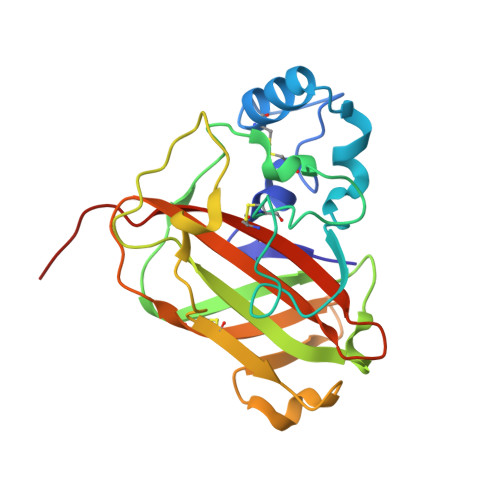Discovery, activity and characterisation of an AA10 lytic polysaccharide oxygenase from the shipworm symbiontTeredinibacter turnerae.
Fowler, C.A., Sabbadin, F., Ciano, L., Hemsworth, G.R., Elias, L., Bruce, N., McQueen-Mason, S., Davies, G.J., Walton, P.H.(2019) Biotechnol Biofuels 12: 232-232
- PubMed: 31583018
- DOI: https://doi.org/10.1186/s13068-019-1573-x
- Primary Citation of Related Structures:
6RW7 - PubMed Abstract:
The quest for novel enzymes for cellulosic biomass-degradation has recently been focussed on lytic polysaccharide monooxygenases (LPMOs/PMOs), Cu-containing proteins that catalyse the oxidative degradation of otherwise recalcitrant polysaccharides using O 2 or H 2 O 2 as a co-substrate. Although classical saprotrophic fungi and bacteria have been a rich source of lytic polysaccharide monooxygenases (LPMOs), we were interested to see if LPMOs from less evident bio-environments could be discovered and assessed for their cellulolytic activity in a biofuel context. In this regard, the marine shipworm Lyrodus pedicellatus represents an interesting source of new enzymes, since it must digest wood particles ingested during its natural tunnel boring behaviour and plays host to a symbiotic bacterium, Teredinibacter turnerae , the genome of which has revealed a multitude of enzymes dedicated to biomass deconstruction. Here, we show that T. turnerae encodes a cellulose-active AA10 LPMO. The 3D structure, at 1.4 Å resolution, along with its EPR spectrum is distinct from other AA10 polysaccharide monooxygenases insofar as it displays a "histidine-brace" catalytic apparatus with changes to the surrounding coordination sphere of the copper. Furthermore, Tt AA10A possesses a second, surface accessible, Cu site 14 Å from the classical catalytic centre. Activity measurements show that the LPMO oxidises cellulose and thereby significantly augments the rate of degradation of cellulosic biomass by classical glycoside hydrolases. Shipworms are wood-boring marine molluscs that can live on a diet of lignocellulose. Bacterial symbionts of shipworms provide many of the enzymes needed for wood digestion. The shipworm symbiont T. turnerae produces one of the few LPMOs yet described from the marine environment, notably adding to the capability of shipworms to digest recalcitrant polysaccharides.
Organizational Affiliation:
1Department of Chemistry, University of York, York, YO10 5DD UK.

















